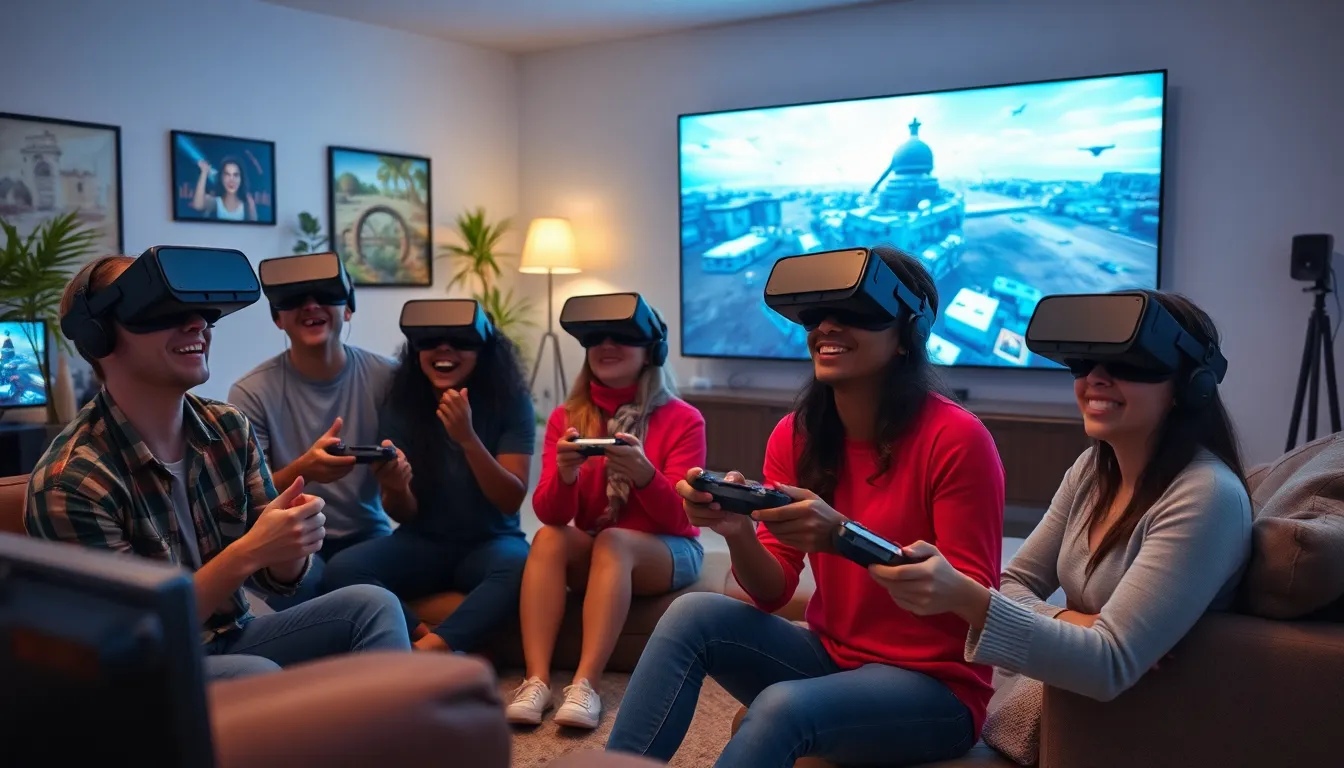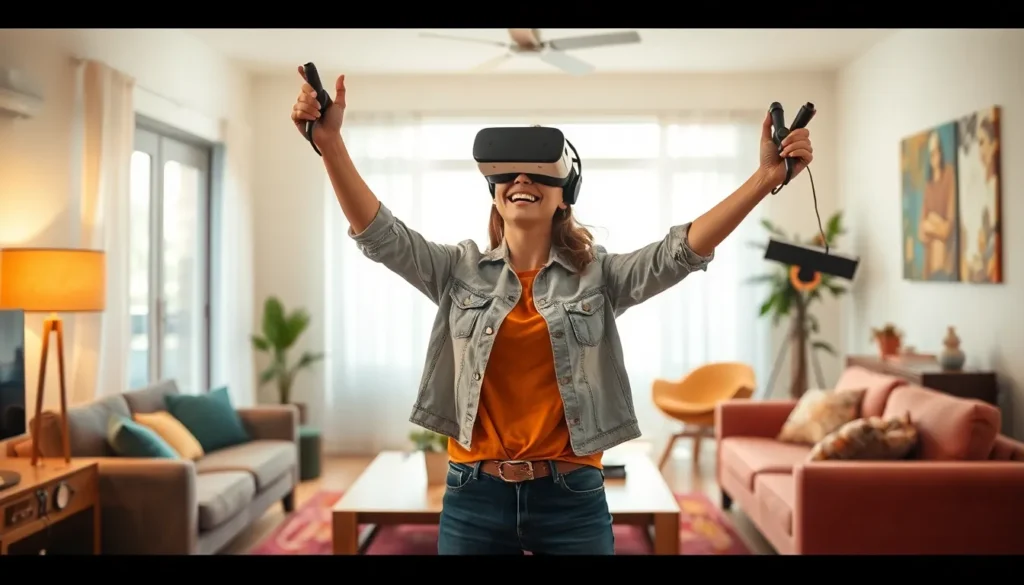Virtual reality apps are revolutionizing the way people experience entertainment, education, and even fitness. Imagine stepping into a world where you can battle dragons, learn to cook gourmet meals, or even take a stroll on Mars—all from the comfort of your living room. It’s like having a magic portal that transports you anywhere you want to go, minus the awkward packing and jet lag.
Table of Contents
ToggleOverview of VR Apps
VR apps encompass a variety of experiences that enhance user interaction in digital environments. Users can find applications across entertainment, education, and fitness sectors. Gaming experiences often take center stage, allowing players to immerse themselves in worlds filled with adventure.
Education benefits from VR apps through interactive lessons that captivate students. Virtual classrooms enable real-time engagement, making complex subjects more accessible. Fitness applications offer workout routines in engaging environments, promoting physical activity through gamified experiences.
Users interact with VR apps through headsets, controllers, and motion sensors, creating a seamless experience. These technologies enhance the sense of presence within virtual worlds, making activities feel more real. Studies indicate that VR can improve learning retention by immersing learners in the content.
Popular VR apps include games like “Beat Saber,” which focuses on rhythm and movement, and educational platforms such as “Engage,” used by institutions for virtual lectures. A diverse range of fitness options exists, including “Supernatural,” which combines workouts with beautiful landscapes.
Emerging trends indicate an increase in VR app development, driven by advances in technology and user demand. Companies are consistently investing in innovative applications to meet varied interests. The future holds potential for even more immersive experiences, as developers explore augmented reality integration with VR frameworks, enhancing user engagement further.
Developers prioritize making VR more accessible and improving user interfaces. Accessibility measures ensure users with disabilities can also benefit from these immersive experiences. Engaging VR apps show that the virtual landscape continues to evolve, offering endless possibilities for creativity and interaction.
Types of VR Apps

Virtual reality applications fall into distinct categories, each offering unique experiences and advantages. These categories encompass gaming, education, and health and fitness, showcasing the versatility of VR technology.
Gaming VR Apps
Gaming VR apps captivate players by immersing them in rich, interactive environments. Titles like “Beat Saber” and “Half-Life: Alyx” transport users into thrilling adventures filled with challenges. Engaging mechanics allow players to interact with their surroundings, enhancing immersion. A sense of presence fosters deeper connections to game narratives and characters. Some platforms also feature multiplayer options, enabling social interaction among friends. The popularity of VR gaming continues to grow, driven by advancements in technology and creative game design.
Educational VR Apps
Educational VR apps transform traditional learning by delivering interactive experiences. Platforms such as “Engage” and “Zentral” facilitate virtual classrooms where students can explore complex topics in an engaging manner. Lessons become more accessible when learners can visualize concepts in three dimensions. Participation encourages collaboration among students, fostering communication and teamwork. Teachers report improved learning retention as students engage with content actively rather than passively. This innovative use of VR in education has the potential to revolutionize how knowledge is acquired and shared.
Health and Fitness VR Apps
Health and fitness VR apps motivate users to elevate their physical activity levels while enjoying immersive environments. Applications like “Supernatural” and “FitXR” combine workouts with beautiful landscapes, creating an engaging experience. Users find themselves participating in gamified fitness routines that promote consistency. Personalized workout tracks cater to different fitness levels and preferences. Many report feeling more inclined to stick with their fitness goals due to the engaging nature of these applications. The integration of VR technology into health and fitness represents a significant advancement in promoting well-being.
Popular VR Apps Today
Virtual reality continues to evolve, with numerous applications gaining popularity across entertainment, education, and fitness sectors. Users experience immersive environments that transport them into diverse worlds.
App Reviews
“Beat Saber” stands out as a leading VR game. Players slice through blocks to the rhythm of music, making it both fun and a great workout. “Engage” offers innovative educational experiences, allowing users to interact in virtual classrooms. Students can participate in lessons that captivate their attention and enhance understanding. “Supernatural” combines fitness with stunning landscapes, motivating users to engage in enjoyable workouts. Each app has unique features, catering to different preferences, ensuring that every user finds something that resonates.
User Feedback
User feedback highlights the immersive qualities of VR apps. Many express excitement about how “Beat Saber” transforms fitness into an enjoyable experience. Additionally, educators appreciate how “Engage” fosters collaboration among students, improving learning outcomes. Reviews emphasize the visual appeal of outdoor settings in “Supernatural,” making workouts feel like adventures. Users frequently mention the intuitive controls and smooth interactions, which significantly enhance their overall experience. Positive reactions showcase the potential of VR to revolutionize how people engage with content, making it a valuable tool in many areas of life.
Future Trends in VR Apps
Technological advancements will drive the evolution of VR applications. Companies are increasingly focusing on immersive experiences, which blend augmented reality and virtual reality. User engagement continues to rise as developers enhance interactive features, aiming to captivate audiences across various sectors.
Accessibility will improve, allowing users with disabilities to experience VR benefits. Innovative designs are emerging, ensuring that everyone can participate in virtual environments without barriers. Social interaction features will gain prominence, enabling users to connect in shared virtual spaces seamlessly.
Industry trends showcase an emphasis on educational applications, transforming traditional learning experiences. VR apps will immerse students in realistic simulations that simplify complex concepts, making education more engaging. Interactive lessons foster collaboration and creativity, paving the way for the next generation of learners.
Healthcare applications are expected to expand, using VR for therapy and rehabilitation. Evidence suggests that immersive environments can alleviate stress and enhance patient outcomes. Fitness-focused VR apps will also increase, integrating gamification with holistic wellness approaches to promote active lifestyles.
Emerging technologies like haptic feedback will enhance user immersion, making virtual environments feel more tangible. Studies indicate that this sensory engagement improves user retention and enjoyment. As VR becomes more accessible and enjoyable, its presence in daily life will continue to grow.
Investments in VR startup companies are on the rise, indicating a vibrant future for application development. Entrepreneurs recognize the potential of the technology, sparking innovations across entertainment, education, and fitness sectors. The next few years promise groundbreaking advancements that will redefine user interactions in virtual spaces.
The future of VR apps is bright and filled with potential. As technology advances users can expect even more immersive experiences that blur the lines between reality and virtual worlds. With a growing focus on accessibility and social interaction these applications will cater to a wider audience ensuring that everyone can benefit from the magic of virtual reality.
From gaming and education to health and fitness VR apps are set to revolutionize how people engage with content. The ongoing investment in this space indicates a commitment to innovation that will continue to enhance user experiences. As VR technology becomes more integrated into daily life it promises to transform entertainment education and wellness in ways that were once unimaginable. The journey into virtual reality is just beginning and the possibilities are endless.




